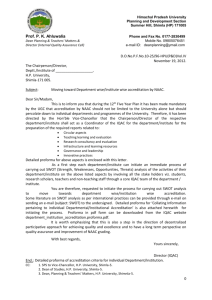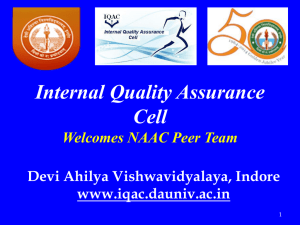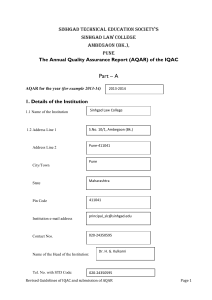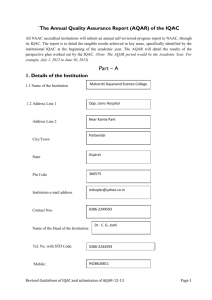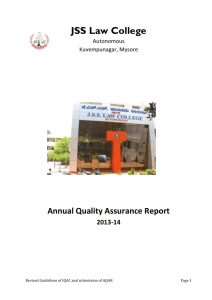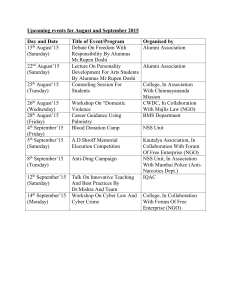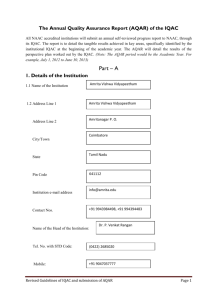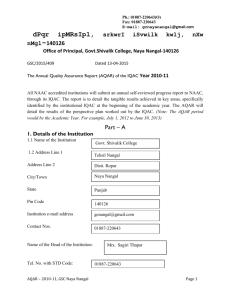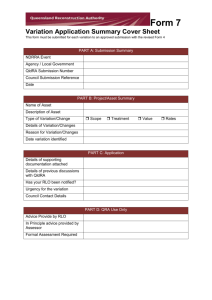Internal Quality Assurance Cell (IQAC)
advertisement
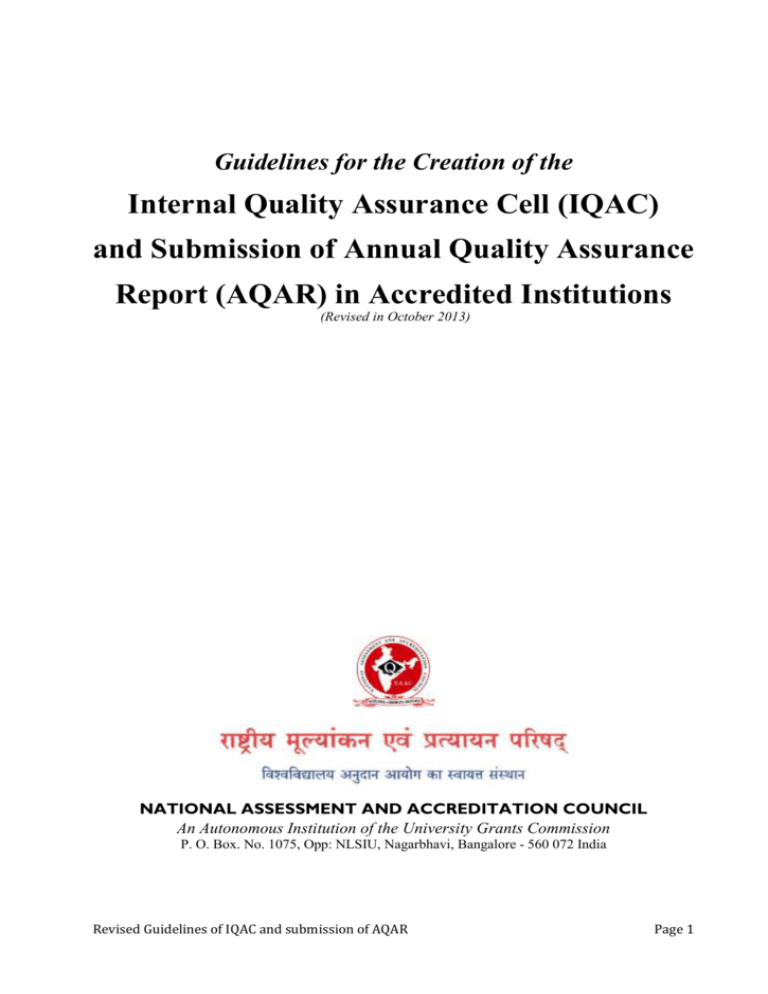
Guidelines for the Creation of the Internal Quality Assurance Cell (IQAC) and Submission of Annual Quality Assurance Report (AQAR) in Accredited Institutions (Revised in October 2013) NATIONAL ASSESSMENT AND ACCREDITATION COUNCIL An Autonomous Institution of the University Grants Commission P. O. Box. No. 1075, Opp: NLSIU, Nagarbhavi, Bangalore - 560 072 India Revised Guidelines of IQAC and submission of AQAR Page 1 NAAC VISION To make quality the defining element of higher education in India through a combination of self and external quality evaluation, promotion and sustenance initiatives. MISSION To arrange for periodic assessment and accreditation of institutions of higher education or units thereof, or specific academic programmes or projects; To stimulate the academic environment for promotion of quality of teaching-learning and research in higher education institutions; To encourage self-evaluation, accountability, autonomy and innovations in higher education; To undertake quality-related research studies, consultancy and training programmes, and To collaborate with other stakeholders of higher education for quality evaluation, promotion and sustenance. Value Framework To promote the following core values among the HEIs of the country: Contributing to National Development Fostering Global Competencies among Students Inculcating a Value System among Students Promoting the Use of Technology Quest for Excellence Revised Guidelines of IQAC and submission of AQAR Page 2 Contents 1. Introduction Page Nos. ...... 4 2. Objective ...... 4 3. Strategies ...... 4 4. Functions ...... 5 5. Benefits ...... 5 6. Composition of the IQAC ...... 5 7. The role of coordinator ...... 6 8. Operational Features of the IQAC ...... 6 9. Monitoring Mechanism ...... 7 10. The Annual Quality Assurance Report (AQAR) of the IQAC ...... 8 Part – A 11. Details of the Institution ...... 9 12. IQAC Composition and Activities ...... 12 Part – B 13. Criterion – I: Curricular Aspects ...... 14 14. Criterion – II: Teaching, Learning and Evaluation ...... 15 15. Criterion – III: Research, Consultancy and Extension ...... 17 16. Criterion – IV: Infrastructure and Learning Resources ...... 20 17. Criterion – V: Student Support and Progression ...... 22 18. Criterion – VI: Governance, Leadership and Management ...... 24 19. Criterion – VII: Innovations and Best Practices ...... 27 20. Abbreviations ...... 29 ___________________________ Document revised by: Dr. Ganesh Hegde, Assistant Adviser and B. S. Ponmudiraj, Assistant Adviser, NAAC Revised Guidelines of IQAC and submission of AQAR Page 3 Guidelines for the Creation of the Internal Quality Assurance Cell (IQAC) and Submission of Annual Quality Assurance Report (AQAR) in Accredited Institutions Introduction In pursuance of its Action Plan for performance evaluation, assessment and accreditation and quality up-gradation of institutions of higher education, the National Assessment and Accreditation Council (NAAC), Bangalore proposes that every accredited institution should establish an Internal Quality Assurance Cell (IQAC) as a post-accreditation quality sustenance measure. Since quality enhancement is a continuous process, the IQAC will become a part of the institution’s system and work towards realisation of the goals of quality enhancement and sustenance. The prime task of the IQAC is to develop a system for conscious, consistent and catalytic improvement in the overall performance of institutions. For this, during the postaccreditation period, it will channelize all efforts and measures of the institution towards promoting its holistic academic excellence. The guidelines provided in the following pages will guide and facilitate the institution in the creation and operation of the Internal Quality Assurance Cell (IQAC). The work of the IQAC is the first step towards internalization and institutionalization of quality enhancement initiatives. Its success depends upon the sense of belongingness and participation it can inculcate in all the constituents of the institution. It will not be yet another hierarchical structure or a record-keeping exercise in the institution. It will be a facilitative and participative voluntary system/unit/organ of the institution. It has the potential to become a vehicle for ushering in quality enhancement by working out planned interventionist strategies to remove deficiencies and enhance quality like the “Quality Circles” in industries. Objective The primary aim of IQAC is To develop a system for conscious, consistent and catalytic action to improve the academic and administrative performance of the institution. To promote measures for institutional functioning towards quality enhancement through internalization of quality culture and institutionalization of best practices. Strategies IQAC shall evolve mechanisms and procedures for a) Ensuring timely, efficient and progressive performance of academic, administrative and financial tasks; Revised Guidelines of IQAC and submission of AQAR Page 4 b) The relevance and quality of academic and research programmes; c) Equitable access to and affordability of academic programmes for various sections of society; d) Optimization and integration of modern methods of teaching and learning; e) The credibility of evaluation procedures; f) Ensuring the adequacy, maintenance and proper allocation of support structure and services; g) Sharing of research findings and networking with other institutions in India and abroad. Functions Some of the functions expected of the IQAC are: a) Development and application of quality benchmarks/parameters for various academic and administrative activities of the institution; b) Facilitating the creation of a learner-centric environment conducive to quality education and faculty maturation to adopt the required knowledge and technology for participatory teaching and learning process; c) Arrangement for feedback response from students, parents and other stakeholders on quality-related institutional processes; d) Dissemination of information on various quality parameters of higher education; e) Organization of inter and intra institutional workshops, seminars on quality related themes and promotion of quality circles; f) Documentation of the various programmes/activities leading to quality improvement; g) Acting as a nodal agency of the Institution for coordinating quality-related activities, including adoption and dissemination of best practices; h) Development and maintenance of institutional database through MIS for the purpose of maintaining /enhancing the institutional quality; i) Development of Quality Culture in the institution; j) Preparation of the Annual Quality Assurance Report (AQAR) as per guidelines and parameters of NAAC, to be submitted to NAAC. Benefits IQAC will facilitate / contribute a) Ensure heightened level of clarity and focus in institutional functioning towards quality enhancement; b) Ensure internalization of the quality culture; b) Ensure enhancement and coordination among various activities of the institution and institutionalize all good practices; c) Provide a sound basis for decision-making to improve institutional functioning; Revised Guidelines of IQAC and submission of AQAR Page 5 d) Act as a dynamic system for quality changes in HEIs; e) Build an organised methodology of documentation and internal communication. Composition of the IQAC IQAC may be constituted in every institution under the Chairmanship of the Head of the institution with heads of important academic and administrative units and a few teachers and a few distinguished educationists and representatives of local management and stakeholders. The composition of the IQAC may be as follows: 1. Chairperson: Head of the Institution 2. A few senior administrative officers 3. Three to eight teachers 4. One member from the Management 5. One/two nominees from local society, Students and Alumni 6. One/two nominees from Employers /Industrialists/stakeholders 7. One of the senior teachers as the coordinator/Director of the IQAC The composition of the IQAC will depend on the size and complexity of the institution. It helps the institutions in planning and monitoring. IQAC also gives stakeholders or beneficiaries a cross-sectional participation in the institution’s quality enhancement activities. The guidelines given here are only indicative and will help the institutions for quality sustenance activities. The membership of such nominated members shall be for a period of two years. The IQAC should meet at least once in every quarter. The quorum for the meeting shall be two-third of the total number of members. The agenda, minutes and Action Taken Reports are to be documented with official signatures and maintained electronically in a retrievable format. It is necessary for the members of the IQAC to shoulder the responsibilities of generating and promoting awareness in the institution and to devote time for working out the procedural details. While selecting these members several precautions need to be taken. A few of them are listed below: It is advisable to choose persons from various backgrounds who have earned respect for integrity and excellence in their teaching and research. Moreover, they should be aware of the ground realities of the institutional environment. They should be known for their commitment to improving the quality of teaching and learning. It would be appropriate to choose as senior administrators, persons in charge of institutional services such as library, computer center, estate, student welfare, administration, academic tasks, examination and planning and development. Revised Guidelines of IQAC and submission of AQAR Page 6 The management representative should be a person who is aware of the institution’s objectives, limitations and strengths and is committed to its improvement. The local society representatives should be of high social standing and should have made significant contributions to society and in particular to education. The role of coordinator The role of the coordinator of the IQAC is crucial in ensuring the effective functioning of all the members. The coordinator of the IQAC may be a senior person with expertise in quality aspects. She/he may be a full-time functionary or, to start with, she/he may be a senior academic /administrator entrusted with the IQAC as an additional responsibility. Secretarial assistance may be facilitated by the administration. It is preferable that the coordinator may have sound knowledge about the computer, its various functions and usage for effective communication. Operational Features of the IQAC Quality assurance is a by-product of ongoing efforts to define the objectives of an institution, to have a work plan to achieve them and to specify the checks and balances to evaluate the degree to which each of the tasks is fulfilled. Hence devotion and commitment to improvement rather than mere institutional control is the basis for devising procedures and instruments for assuring quality. The right balance between the health and growth of an institution needs to be struck. The IQAC has to ensure that whatever is done in the institution for “education” is done efficiently and effectively with high standards. In order to do this, the IQAC will have to first establish procedures and modalities to collect data and information on various aspects of institutional functioning. The coordinator of the IQAC and the secretary will have a major role in implementing these functions. The IQAC may derive major support from the already existing units and mechanisms that contribute to the functions listed above. The operational features and functions discussed so far are broad-based to facilitate institutions towards academic excellence and institutions may adapt them to their specific needs. Monitoring Mechanism The institutions need to submit yearly the Annual Quality Assurance Report (AQAR) to NAAC. A functional Internal Quality Assurance Cell (IQAC) and timely submission of Annual Quality Assurance Reports (AQARs) are the Minimum Institutional Requirements (MIR) to volunteer for second, third or subsequent cycle’s accreditation. During the institutional visit the NAAC peer teams will interact with the IQACs to know the progress, functioning as well quality sustenance initiatives undertaken by them. The Annual Quality Assurance Reports (AQAR) may be the part of the Annual Report. The AQAR shall be approved by the statutory bodies of the HEIs (such as Syndicate, Governing Council/Board) for the follow up action for necessary quality enhancement measures. Revised Guidelines of IQAC and submission of AQAR Page 7 The Higher Education Institutions (HEI) shall submit the AQAR regularly to NAAC. The IQACs may create its exclusive window on its institutional website and regularly upload/ report on its activities, as well as for hosting the AQAR. The NAAC Accredited institutions need to submit only the soft copy as word file (.doc/.docx) through e-mail (naac.aqar@gmail.com). The file name needs to be submitted with Track ID of the institution and College Name. For example MHCOGN16601-Samudra Arts and Science College, Taliamegu-Maharashtra.doc or EC_32_A&A_143 dated 3-5-2004-Samudra Arts and Science College, Taliamegu-Maharashtra.doc. The Higher Education Institutions need not submit the printed/hard copy to NAAC. The acknowledgements would be sent to the institutions through e-mail. Revised Guidelines of IQAC and submission of AQAR Page 8 The Annual Quality Assurance Report (AQAR) of the IQAC All NAAC accredited institutions will submit an annual self-reviewed progress report to NAAC, through its IQAC. The report is to detail the tangible results achieved in key areas, specifically identified by the institutional IQAC at the beginning of the academic year. The AQAR will detail the results of the perspective plan worked out by the IQAC. (Note: The AQAR period would be the Academic Year. For example, July 1, 2012 to June 30, 2013) Part – A 1. Details of the Institution 1.1 Name of the Institution 1.2 Address Line 1 Address Line 2 City/Town State Pin Code Institution e-mail address Contact Nos. Name of the Head of the Institution: Tel. No. with STD Code: Mobile: Revised Guidelines of IQAC and submission of AQAR Page 9 Name of the IQAC Co-ordinator: Mobile: IQAC e-mail address: 1.3 NAAC Track ID (For ex. MHCOGN 18879) 1.4 NAAC Executive Committee No. & Date: (For Example EC/32/A&A/143 dated 3-5-2004. This EC no. is available in the right corner- bottom of your institution’s Accreditation Certificate) 1.5 Website address: Web-link of the AQAR: For ex. http://www.ladykeanecollege.edu.in/AQAR2012-13.doc 1.6 Accreditation Details Sl. No. Cycle 1 1st Cycle 2 2nd Cycle 3 3rd Cycle 4 4th Cycle Grade CGPA 1.7 Date of Establishment of IQAC : Year of Accreditation Validity Period DD/MM/YYYY 1.8 AQAR for the year (for example 2010-11) Revised Guidelines of IQAC and submission of AQAR Page 10 1.9 Details of the previous year’s AQAR submitted to NAAC after the latest Assessment and Accreditation by NAAC ((for example AQAR 2010-11submitted to NAAC on 12-10-2011) i. AQAR _______________________ __________________ (DD/MM/YYYY)4 ii. AQAR__________________ ________________________ (DD/MM/YYYY) iii. AQAR__________________ _______________________ (DD/MM/YYYY) iv. AQAR__________________ _______________________ (DD/MM/YYYY) 1.10 Institutional Status University State Affiliated College Yes No Constituent College Yes No Yes No Autonomous college of UGC Regulatory Agency approved Institution Central Deemed Yes Private No (eg. AICTE, BCI, MCI, PCI, NCI) Type of Institution Financial Status Co-education Men Women Urban Rural Tribal Grant-in-aid UGC 2(f) Grant-in-aid + Self Financing UGC 12B Totally Self-financing 1.11 Type of Faculty/Programme Arts TEI (Edu) Science Engineering Commerce Law Health Science PEI (Phys Edu) Management Others (Specify) Revised Guidelines of IQAC and submission of AQAR Page 11 1.12 Name of the Affiliating University (for the Colleges) 1.13 Special status conferred by Central/ State Government-- UGC/CSIR/DST/DBT/ICMR etc Autonomy by State/Central Govt. / University University with Potential for Excellence UGC-CPE DST Star Scheme UGC-CE UGC-Special Assistance Programme DST-FIST UGC-Innovative PG programmes Any other (Specify) UGC-COP Programmes 2. IQAC Composition and Activities 2.1 No. of Teachers 2.2 No. of Administrative/Technical staff 2.3 No. of students 2.4 No. of Management representatives 2.5 No. of Alumni 2. 6 No. of any other stakeholder and community representatives 2.7 No. of Employers/ Industrialists 2.8 No. of other External Experts 2.9 Total No. of members Revised Guidelines of IQAC and submission of AQAR Page 12 2.10 No. of IQAC meetings held 2.11 No. of meetings with various stakeholders: No. Faculty Non-Teaching Staff Students Alumni Others 2.12 Has IQAC received any funding from UGC during the year? Yes No If yes, mention the amount 2.13 Seminars and Conferences (only quality related) (i) No. of Seminars/Conferences/ Workshops/Symposia organized by the IQAC Total Nos. International National State Institution Level (ii) Themes 2.14 Significant Activities and contributions made by IQAC 2.15 Plan of Action by IQAC/Outcome The plan of action chalked out by the IQAC in the beginning of the year towards quality enhancement and the outcome achieved by the end of the year * Plan of Action Achievements * Attach the Academic Calendar of the year as Annexure. 2.15 Whether the AQAR was placed in statutory body Management Syndicate Yes No Any other body Provide the details of the action taken Revised Guidelines of IQAC and submission of AQAR Page 13 Part – B Criterion – I 1. Curricular Aspects 1.1 Details about Academic Programmes Level of the Programme Number of existing Programmes Number of programmes added during the year Number of self-financing programmes Number of value added / Career Oriented programmes PhD PG UG PG Diploma Advanced Diploma Diploma Certificate Others Total Interdisciplinary Innovative 1.2 (i) Flexibility of the Curriculum: CBCS/Core/Elective option / Open options (ii) Pattern of programmes: Pattern Number of programmes Semester Trimester Annual 1.3 Feedback from stakeholders* Alumni (On all aspects) Mode of feedback : Online Parents Manual Employers Students Co-operating schools (for PEI) *Please provide an analysis of the feedback in the Annexure 1.4 Whether there is any revision/update of regulation or syllabi, if yes, mention their salient aspects. 1.5 Any new Department/Centre introduced during the year. If yes, give details. Revised Guidelines of IQAC and submission of AQAR Page 14 Criterion – II 2. Teaching, Learning and Evaluation 2.1 Total No. of permanent faculty Total Asst. Professors Associate Professors Professors Others 2.2 No. of permanent faculty with Ph.D. 2.3 No. of Faculty Positions Recruited (R) and Vacant (V) during the year Asst. Professors Associate Professors Professors Others R R R R V V V Total V R V 2.4 No. of Guest and Visiting faculty and Temporary faculty 2.5 Faculty participation in conferences and symposia: No. of Faculty Attended Seminars/ papers Presented Workshops Resource Persons International level National level State level 2.6 Innovative processes adopted by the institution in Teaching and Learning: 2.7 Total No. of actual teaching days during this academic year 2.8 Examination/ Evaluation Reforms initiated by the Institution (for example: Open Book Examination, Bar Coding, Double Valuation, Photocopy, Online Multiple Choice Questions) 2.9 No. of faculty members involved in curriculum restructuring/revision/syllabus development as member of Board of Study/Faculty/Curriculum Development workshop 2.10 Average percentage of attendance of students Revised Guidelines of IQAC and submission of AQAR Page 15 Revised Guidelines of IQAC and submission of AQAR Page 16 2.11 Course/Programme wise distribution of pass percentage : Title of the Programme Total no. of students appeared Division Distinction % I% II % III % Pass % 2.12 How does IQAC Contribute/Monitor/Evaluate the Teaching & Learning processes : 2.13 Initiatives undertaken towards faculty development Number of faculty benefitted Faculty / Staff Development Programmes Refresher courses UGC – Faculty Improvement Programme HRD programmes Orientation programmes Faculty exchange programme Staff training conducted by the university Staff training conducted by other institutions Summer / Winter schools, Workshops, etc. Others 2.14 Details of Administrative and Technical staff Category Number of Permanent Employees Number of Vacant Positions Number of permanent positions filled during the Year Number of positions filled temporarily Administrative Staff Technical Staff Revised Guidelines of IQAC and submission of AQAR Page 17 Criterion – III 3. Research, Consultancy and Extension 3.1 Initiatives of the IQAC in Sensitizing/Promoting Research Climate in the institution 3.2 Details regarding major projects Completed Ongoing Sanctioned Submitted Ongoing Sanctioned Submitted Number Outlay in Rs. Lakhs 3.3 Details regarding minor projects Completed Number Outlay in Rs. Lakhs 3.4 Details on research publications International National Others Peer Review Journals Non-Peer Review Journals e-Journals Conference proceedings 3.5 Details on Impact factor of publications: Range Average h-index Nos. in SCOPUS 3.6 Research funds sanctioned and received from various funding agencies, industry and other organisations Nature of the Project Duration Year Name of the funding Agency Total grant sanctioned Received Major projects Minor Projects Interdisciplinary Projects Industry sponsored Projects sponsored by the University/ College Students research projects (other than compulsory by the University) Any other(Specify) Total Revised Guidelines of IQAC and submission of AQAR Page 18 3.7 No. of books published i) With ISBN No. Chapters in Edited Books ii) Without ISBN No. 3.8 No. of University Departments receiving funds from UGC-SAP CAS DST-FIST DPE 3.9 For colleges DBT Scheme/funds Autonomy CPE INSPIRE DBT Star Scheme CE Any Other (specify) 3.10 Revenue generated through consultancy 3.11 No. of conferences organized by the Institution Level Number Sponsoring agencies International National State University College 3.12 No. of faculty served as experts, chairpersons or resource persons 3.13 No. of collaborations International National Any other 3.14 No. of linkages created during this year 3.15 Total budget for research for current year in lakhs : From Funding agency From Management of University/College Total 3.16 No. of patents received this year Type of Patent National International Commercialised Revised Guidelines of IQAC and submission of AQAR Number Applied Granted Applied Granted Applied Granted Page 19 3.17 No. of research awards/ recognitions received by faculty and research fellows Of the institute in the year Total International National State University Dist College 3.18 No. of faculty from the Institution who are Ph. D. Guides and students registered under them 3.19 No. of Ph.D. awarded by faculty from the Institution 3.20 No. of Research scholars receiving the Fellowships (Newly enrolled + existing ones) JRF SRF Project Fellows Any other 3.21 No. of students Participated in NSS events: University level State level National level International level University level State level National level International level University level State level National level International level University level State level National level International level 3.22 No. of students participated in NCC events: 3.23 No. of Awards won in NSS: 3.24 No. of Awards won in NCC: Revised Guidelines of IQAC and submission of AQAR Page 20 3.25 No. of Extension activities organized University forum College forum NCC NSS Any other 3.26 Major Activities during the year in the sphere of extension activities and Institutional Social Responsibility Criterion – IV 4. Infrastructure and Learning Resources 4.1 Details of increase in infrastructure facilities: Facilities Existing Newly created Source of Fund Total Campus area Class rooms Laboratories Seminar Halls No. of important equipments purchased (≥ 1-0 lakh) during the current year. Value of the equipment purchased during the year (Rs. in Lakhs) Others 4.2 Computerization of administration and library Revised Guidelines of IQAC and submission of AQAR Page 21 4.3 Library services: Existing No. Value Newly added No. Value Total No. Value Text Books Reference Books e-Books Journals e-Journals Digital Database CD & Video Others (specify) 4.4 Technology up gradation (overall) Total Computers Computer Labs Internet Browsing Centres Computer Centres Office Departments Others Existing Added Total 4.5 Computer, Internet access, training to teachers and students and any other programme for technology upgradation (Networking, e-Governance etc.) 4.6 Amount spent on maintenance in lakhs : i) ICT ii) Campus Infrastructure and facilities iii) Equipments iv) Others Total : Revised Guidelines of IQAC and submission of AQAR Page 22 Criterion – V 5. Student Support and Progression 5.1 Contribution of IQAC in enhancing awareness about Student Support Services 5.2 Efforts made by the institution for tracking the progression 5.3 (a) Total Number of students UG PG Ph. D. Others (b) No. of students outside the state (c) No. of international students No % Men No % Women Last Year General SC ST OBC This Year Physically Challenged Demand ratio Total General SC ST OBC Physically Total Challenged Dropout % 5.4 Details of student support mechanism for coaching for competitive examinations (If any) No. of students beneficiaries Revised Guidelines of IQAC and submission of AQAR Page 23 5.5 No. of students qualified in these examinations NET SET/SLET GATE CAT IAS/IPS etc State PSC UPSC Others 5.6 Details of student counselling and career guidance No. of students benefitted 5.7 Details of campus placement On campus Number of Organizations Visited Off Campus Number of Students Participated Number of Students Placed Number of Students Placed 5.8 Details of gender sensitization programmes 5.9 Students Activities 5.9.1 No. of students participated in Sports, Games and other events State/ University level National level International level No. of students participated in cultural events State/ University level National level Revised Guidelines of IQAC and submission of AQAR International level Page 24 5.9.2 No. of medals /awards won by students in Sports, Games and other events Sports : State/ University level National level International level Cultural: State/ University level National level International level 5.10 Scholarships and Financial Support Number of students Amount Financial support from institution Financial support from government Financial support from other sources Number of students who received International/ National recognitions 5.11 Student organised / initiatives Fairs : State/ University level National level International level Exhibition: State/ University level National level International level 5.12 No. of social initiatives undertaken by the students 5.13 Major grievances of students (if any) redressed: ______________________________________ Criterion – VI 6. Governance, Leadership and Management 6.1 State the Vision and Mission of the institution 6.2 Does the Institution has a management Information System Revised Guidelines of IQAC and submission of AQAR Page 25 6.3 Quality improvement strategies adopted by the institution for each of the following: 6.3.1 Curriculum Development 6.3.2 Teaching and Learning 6.3.3 Examination and Evaluation 6.3.4 Research and Development 6.3.5 Library, ICT and physical infrastructure / instrumentation 6.3.6 Human Resource Management 6.3.7 Faculty and Staff recruitment 6.3.8 Industry Interaction / Collaboration Revised Guidelines of IQAC and submission of AQAR Page 26 6.3.9 Admission of Students Teaching Non teaching Students 6.4 Welfare schemes for 6.5 Total corpus fund generated 6.6 Whether annual financial audit has been done Yes No 6.7 Whether Academic and Administrative Audit (AAA) has been done? Audit Type External Yes/No Internal Agency Yes/No Authority Academic Administrative 6.8 Does the University/ Autonomous College declares results within 30 days? For UG Programmes Yes No For PG Programmes Yes No 6.9 What efforts are made by the University/ Autonomous College for Examination Reforms? 6.10 What efforts are made by the University to promote autonomy in the affiliated/constituent colleges? Revised Guidelines of IQAC and submission of AQAR Page 27 6.11 Activities and support from the Alumni Association 6.12 Activities and support from the Parent – Teacher Association 6.13 Development programmes for support staff 6.14 Initiatives taken by the institution to make the campus eco-friendly Criterion – VII 7. Innovations and Best Practices 7.1 Innovations introduced during this academic year which have created a positive impact on the functioning of the institution. Give details. 7.2 Provide the Action Taken Report (ATR) based on the plan of action decided upon at the beginning of the year Revised Guidelines of IQAC and submission of AQAR Page 28 7.3 Give two Best Practices of the institution (please see the format in the NAAC Self-study Manuals) *Provide the details in annexure (annexure need to be numbered as i, ii,iii) 7.4 Contribution to environmental awareness / protection 7.5 Whether environmental audit was conducted? Yes No 7.6 Any other relevant information the institution wishes to add. (for example SWOT Analysis) 8. Plans of institution for next year Name _______________________________ Name _______________________________ _______________________________ _______________________________ Signature of the Coordinator, IQAC Signature of the Chairperson, IQAC _______***_______ Revised Guidelines of IQAC and submission of AQAR Page 29 Annexure I Abbreviations: CAS - Career Advanced Scheme CAT - Common Admission Test CBCS - Choice Based Credit System CE - Centre for Excellence COP - Career Oriented Programme CPE - College with Potential for Excellence DPE - Department with Potential for Excellence GATE - Graduate Aptitude Test NET - National Eligibility Test PEI - Physical Education Institution SAP - Special Assistance Programme SF - Self Financing SLET - State Level Eligibility Test TEI - Teacher Education Institution UPE - University with Potential Excellence UPSC - Union Public Service Commission *************** Revised Guidelines of IQAC and submission of AQAR Page 30
